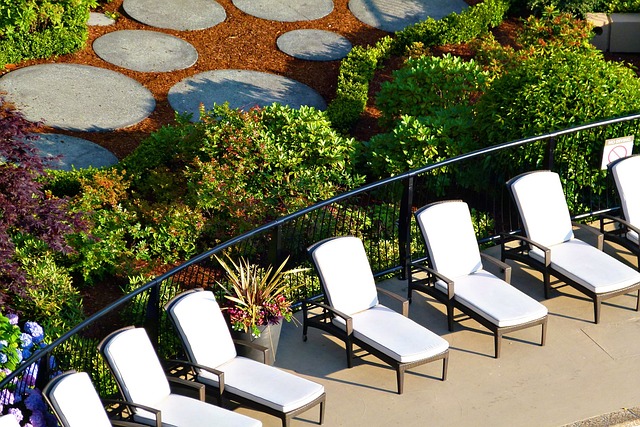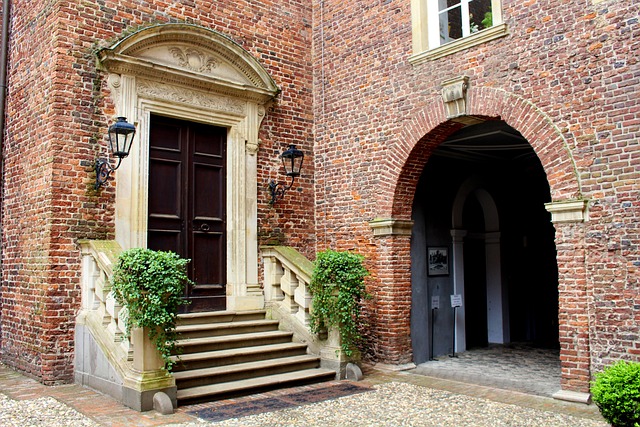When planning a custom patio, it's vital to assess your outdoor space's dimensions and environmental factors like sunlight and wind direction to ensure the design meets your lifestyle needs, whether for relaxation or entertainment. Choosing the right materials is key; they must be durable, weather-resistant, and low-maintenance, suitable for your local climate, be it sunny, cold, rainy, or windy. Materials like treated wood or composite decking can prevent rot and withstand harsh conditions. The patio design should also consider thermal comfort and energy efficiency by using insulating materials beneath the space. Aesthetic elements such as color schemes, textures, and thoughtful lighting are important to create a visually appealing and versatile outdoor sanctuary that complements your home's style. Enhance this with practical features like seating, fire pits, kitchens, or water features, and ensure privacy and safety with strategic landscaping. The goal is to craft a personalized patio retreat that reflects your tastes and serves your daily needs year-round.
Embark on transforming your outdoor living space with a custom patio or deck design that harmonizes functionality with aesthetics. This article guides you through assessing your available area, selecting durable materials, and integrating various elements that elevate your backyard into an extension of your home. We delve into key considerations for custom patio design, exploring how to evaluate space and purpose, adapt to different climates, and blend form with function. Additionally, we examine the best materials and construction techniques for a stable and long-lasting deck. From there, learn how to enhance your outdoor experience with fire features, seamless transitions, and ambient lighting. Finally, discover creative design elements that will not only captivate but also add value to your patio. Whether you’re seeking a tranquil retreat or an entertainment hub, this comprehensive guide offers insights for crafting a unique and inviting outdoor environment.
- Assessing Your Outdoor Space: Key Considerations for Custom Patio Design
- – Evaluating Space and Purpose
- – Climate and Material Selection
- – Integrating Functionality with Aesthetics
Assessing Your Outdoor Space: Key Considerations for Custom Patio Design

When contemplating a custom patio design, the first step is to assess your outdoor space with meticulous attention to its dimensions, exposure to sunlight, and existing features that can complement or be integrated into the new design. Understanding the prevailing weather patterns, wind direction, and the natural flow of your yard will inform decisions about patio placement and orientation. This thorough evaluation ensures that the final design not only fits aesthetically but also functions optimally within its environment.
Consideration of your lifestyle and how you intend to use the space is paramount. Determine if you desire a tranquil retreat or an entertainment hub. Your preferences will dictate the size, materials, and features such as built-in seating, outdoor kitchens, fire pits, or pergolas. Selecting durable, weather-resistant materials that align with your region’s climate will extend the longevity and maintenance requirements of your patio. A well-planned custom patio design, tailored to your specific needs and preferences, transforms ordinary outdoor space into an exceptional living extension.
– Evaluating Space and Purpose

When considering a custom patio or deck design, the first step is to evaluate the available space and determine its purpose. A well-designed patio not only enhances the aesthetic appeal of your outdoor area but also serves as an extension of your living space, tailored to your lifestyle. Assess the dimensions and layout of your yard, taking into account sun exposure, wind patterns, and privacy needs. This meticulous evaluation ensures that the design will maximize usable space and accommodate intended activities, whether it’s dining, lounging, or entertaining. By aligning the design with the desired function, homeowners can create a personalized outdoor retreat that offers both beauty and utility.
In conjunction with spatial assessment, selecting appropriate materials and features becomes paramount. Durability and maintenance requirements should align with the intended use of the patio or deck. For instance, if the space is intended for family gatherings and play, low-maintenance materials like composite decking might be preferable. Similarly, for a serene reading nook, weather-resistant fabrics and finishes that complement the surrounding landscape can enhance the ambiance. By carefully considering these elements in relation to your personal needs and the intended purpose of the space, you can ensure a custom patio or deck design that not only meets but exceeds your expectations.
– Climate and Material Selection

When designing a custom patio or deck, careful consideration of local climate conditions is paramount to ensure the structure’s durability and comfort for its intended use. Materials selected must withstand the area’s typical weather patterns, whether it’s the harsh UV rays of sunny climates or the frost and snow of colder regions. For instance, in areas prone to heavy rainfall, choosing water-resistant materials like treated wood or composite decking can prevent rot and decay. Similarly, in regions with high heat, materials with reflective properties will help mitigate the effects of solar radiation. Additionally, insulating materials beneath the patio or deck can provide thermal comfort and reduce energy costs by maintaining a more stable temperature below. The right choice of materials not only extends the lifespan of your outdoor space but also enhances its aesthetic appeal and functionality throughout the year.
The selection of materials is a critical decision that affects both the longevity of your patio or deck and its visual impact. For example, in regions with significant snowfall, the use of heat-reflective materials can prevent snow from melting and refreezing into ice, which could otherwise cause structural stress. Furthermore, for areas with high winds, selecting robust materials that offer stability against wind uplift is essential. Durability isn’t just about resisting the elements; it’s also about choosing materials that complement the design vision for your outdoor space. Whether opting for the natural look of timber or the contemporary feel of stone and glass, the material palette you choose sets the foundation for both the patio’s functionality and its aesthetic appeal.
– Integrating Functionality with Aesthetics

When designing a custom patio or deck, the harmonious blend of functionality and aesthetics is key to creating an outdoor space that is both pleasing to the eye and fully equipped to meet the needs of its users. A well-designed patio should not only serve as a beautiful extension of your home but also cater to various activities, from dining to lounging or entertaining. Aesthetic elements such as the choice of materials, color palettes, and textures play a crucial role in setting the ambiance, while practical considerations like space efficiency, weatherproofing, and lighting ensure the patio is usable throughout the year. Homeowners can choose from an array of design options, including built-in seating, fire pits, outdoor kitchens, or water features, all tailored to complement the architecture of the home and enhance the outdoor living experience.
Incorporating smart landscaping alongside your patio design adds a layer of cohesion that ties the natural environment with the man-made structure. Strategic placement of plants, trees, and flowers can not only provide privacy and windbreak but also seasonal color and fragrance, contributing to the overall allure of the space. The integration of outdoor lighting is another aspect that should be considered; it not only accentuates the beauty of your patio but also ensures safety and usability after dark. With careful planning and a focus on both form and function, your custom patio or deck can become an oasis that reflects your personal style while accommodating your lifestyle needs.
When embarking on a custom patio or deck design and installation project, homeowners are encouraged to carefully assess their outdoor space. This process includes evaluating available space and intended use, selecting appropriate materials to withstand local climate conditions, and thoughtfully blending functionality with aesthetics. By prioritizing these elements, the result is a bespoke patio that enhances both the property’s value and the homeowners’ outdoor living experience. For those seeking professional assistance, engaging with experienced designers and contractors who understand your vision can bring these projects to fruition seamlessly. A well-designed patio not only serves as an extension of your living space but also as a personal retreat that reflects your style and comfort, making it a worthwhile investment for any home.
